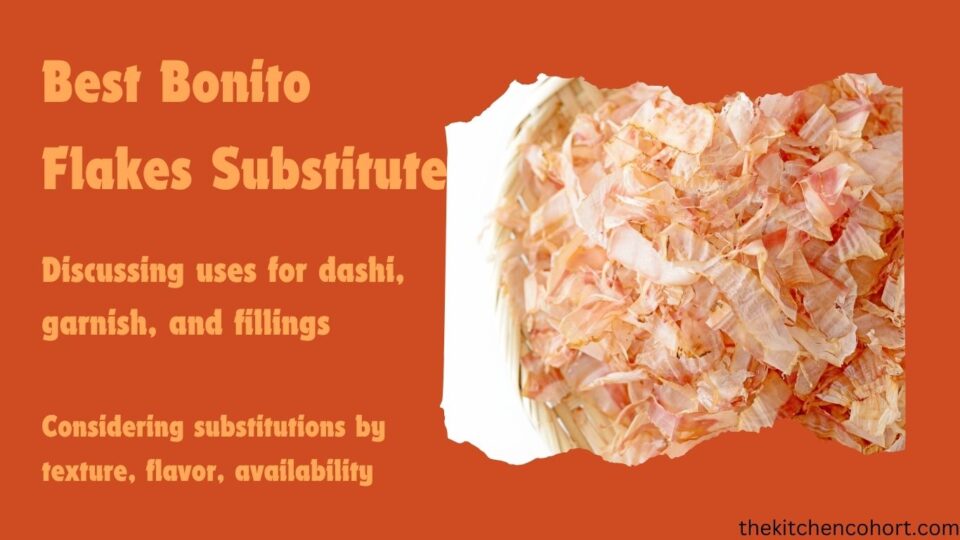Finding a bonito flakes substitute is a difficult venture. Also known as katsuobushi and okaka, they are a very common ingredient in Japanese cuisine. They provide a unique texture and flavor that’s pretty hard to replicate with other ingredients.
Yet, substitution is possible with some tradeoffs in texture, umami flavor, or the smoky flavor of the flakes. If you’re making dashi (stock using bonito flakes), using instant dashi will make the process much easier. Another option is to make a different type of dashi that doesn’t rely on bonito flakes, but can give similar results in flavor and texture.
Of course, your creativity and the recipe will dictate your choice of substitute. The options listed here attempt to cover the availability issues with bonito flakes as well as diet preferences, including vegan or fish-free diets.
Some substitutes for bonito flakes are mackerel powder, stock made from kombu and/or dried shiitake mushrooms, liquid or powdered instant dashi, baby anchovies, or even bacon!
Let’s discuss these alternatives and other cooking options in detail, so you can find the right fit for your recipe.
Table of Contents
Discussing The Right Bonito Flakes Substitute For Your Recipe
1. Shiro Dashi Or Instant Dashi
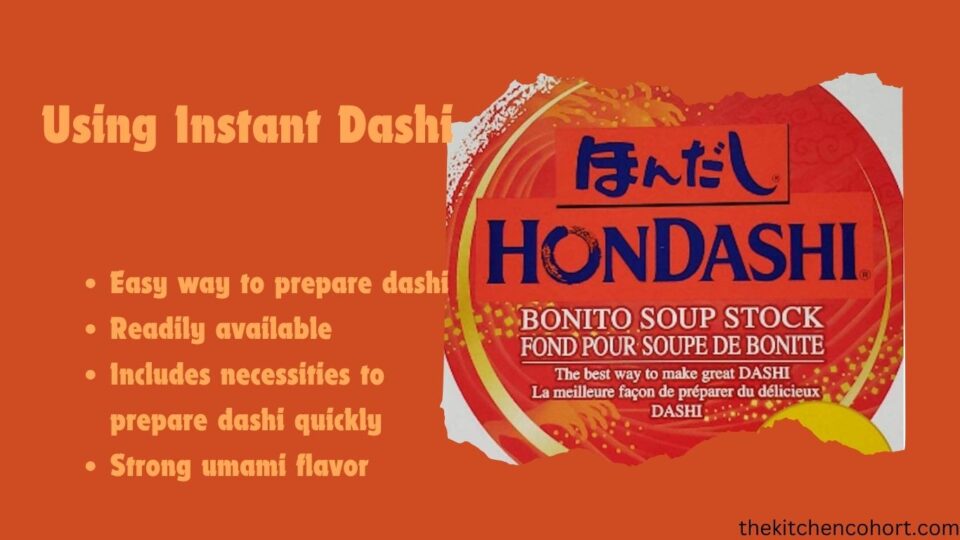
If you need bonito flakes for dashi, it’s a decent idea to skip the process and use instant dashi for the recipe. Some people frown upon using instant dashi and would prefer to go about cooking the old-fashioned way. But it isn’t very fruitful to be obstinate on these choices.
Instant dashi is very popular and is often used for Japanese cuisine, even by seasoned cooks. It’s simply the more convenient choice.
Typically, a recipe for dashi would ask for karebushi or honkarebushi type of katsuobushi (bonito flakes). So, if your recipe has either of these names, you’re good to go with instant dashi.
Since we’re substituting for bonito flakes, look for an instant dashi that includes bonito flakes. Many of these do. Brands/products like Hondashi are fairly well-known, though you can try whatever suits you best. Instant dashi is available in powdered form, as a liquid, and even as bouillon cubes. Usually, instant dashi is more easily available in places outside of Japan.
While the exact composition can vary by brand, most instant dashi will include bonito flakes (powdered), salt, monosodium glutamate (MSG), and disodium inosinate. Notice the presence of disodium inosinate; bonito flakes contain a significant amount of this compound, so adding more of it is a way to enhance the flavors further.
Due to the focus on umami flavoring, instant dashi can have a stronger but less subtle flavor than conventional dashi.
2. Mackerel Powder
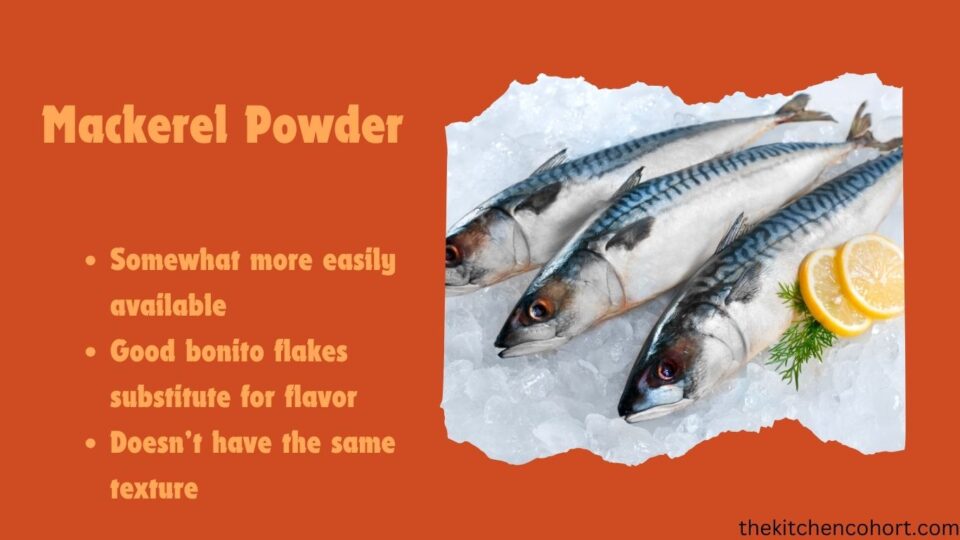
Mackerel powder or powdered mackerel could well be considered the closest alternative to bonito flakes in a recipe. There are quite a bit of similarities between both these ingredients, which is why the substitution works so well.
Powdered mackerel is derived from fish as well and tends to have a similar fish-like flavor and umami tones as bonito flakes. However, it lacks the same texture or the smoky tones. Yet, if you need a more accessible substitute, powdered mackerel can work just fine in place of bonito flakes.
3. Vegan Dashi With Kombu And Shiitake Mushrooms
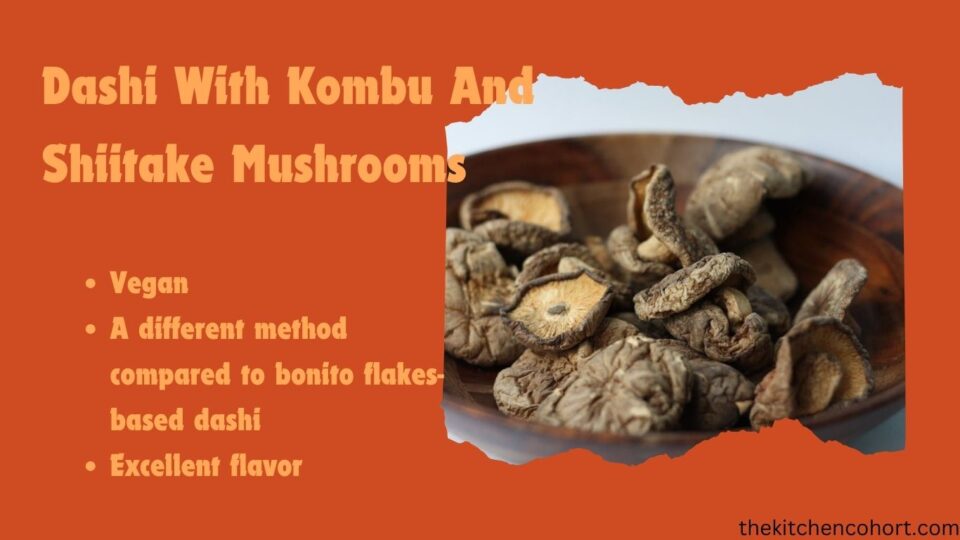
Vegan dashi is also known as Temple Dashi or Shojin Dashi. It is made using kombu (dried kelp) and dried (and rehydrated) shiitake mushrooms. This dashi is an excellent choice for vegans or vegetarians who want to enjoy foods that would otherwise contain bonito flakes.
Keep in mind, vegan dashi is not a plain alternative to bonito flakes. As in, you don’t just put in kombu and shiitake mushrooms in place of bonito flakes. This is a different type of dashi. It yields results similar to those with bonito flakes, but must be prepared in a different way.
The temple dashi involves rehydrating dried shiitake mushrooms. For this purpose, the kombu and mushrooms should be soaked in water overnight. After that, you can heat them up again to have that warm dashi stock ready.
Though quite time-consuming, the resulting dashi is quite flavorful and a treat worthy of enjoyment. Vegan dashi is an excellent substitute to dashi made with bonito flakes.
3. Kombu (Konbu)
A dashi made from kombu can be a good substitute for bonito flakes used in a dashi. Kombu is a type of dried kelp or seaweed and finds several uses in Japanese cuisine. One of these uses is making dashi. In fact, kombu-based dashi is considered one of the easiest to make.
As we’ve already seen, kombu and shiitake mushroom combination is a great way to get vegan dashi. However, should you not have access to shiitake mushrooms or don’t have time to go about with the rehydrating process, using plain kombu can work.
It works, but it’s also a compromise. Kombu dashi isn’t nearly as flavorful as Katsuo Dashi (dashi made from bonito flakes). Using additives like disodium inosinate, liquid smoke, adzuki beans, and soybeans can help get more depth of flavor.
4. Shiitake Mushrooms
We’ve already discussed the shiitake mushrooms and kombu combo, but they can be used individually as well. It is possible to make a good dashi by rehydrating dried shiitake mushrooms.
When making dashi, it is usually best to keep the mushrooms soaked overnight for better flavor. Yet, you would want some additives to give this dashi a better depth of flavor to match the bonito flakes it intends to substitute.
Apart from dashi, shiitake mushrooms can also be a good substitute for bonito flakes where texture and flavor are concerned. These include fillings like onigiri, where the usual filling made from bonito flakes can be replaced by using rehydrated shiitake mushrooms, seasoned with usual ingredients like soy sauce, mirin, sugar, etc.
The mushrooms can bring a similar texture, and also have those umami undertones that make bonito flakes so awesome.
5. Baby Anchovies
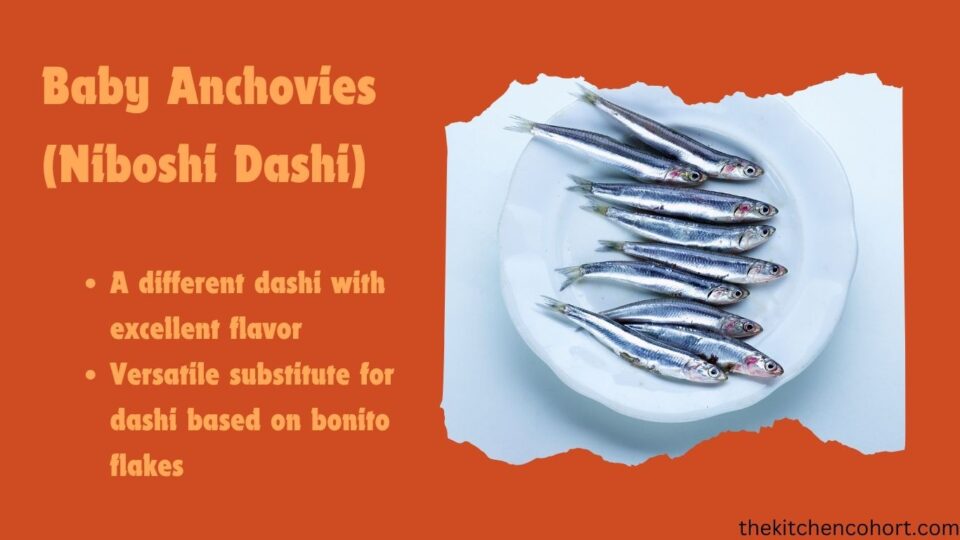
You can make a decent alternative to bonito flakes using baby anchovies. The dashi so made is usually called Iriko dashi or Niboshi dashi.
This type of dashi is very common and often serves as the base of miso soup. Other uses include udon (noodle soup), donburi (rice bowl), mentsuyu, and more. It can sometimes be favored over bonito flakes as well. Niboshi is usually made using anchovies or baby anchovies.
However, it’s also possible to use other small fish for this purpose, including sardines. If you choose to take this route and use sardines, try not to use sardines canned in oil. The presence of oil can have an undesirable effect on the dashi.
When using baby anchovies as a substitute for bonito flakes in dashi, the preparation process will change. Technically, you’ll now be making Iriko or Niboshi dashi, rather than Katsuo dashi that’s usually made with bonito flakes.
Expect some changes in texture and flavors, but the substitution overall works pretty well.
6. Bacon
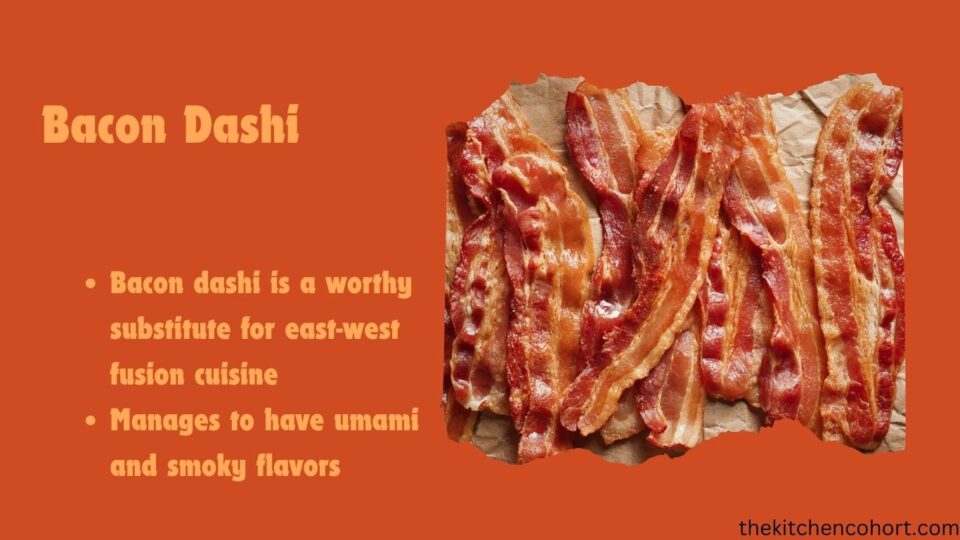
Now here’s a substitution that’s practically out of the blue and very different from the substitutions we’ve considered so far. The use of bacon might seem far removed from conventional Japanese cuisine, or for that matter, even from bonito flakes.
Yet, famous writer and restaurateur David Chang says Bacon Dashi can be a thing! And we’re not inclined to disagree!
David Chang is the founder of Momofuku culinary brand. Amongst other things, this brand also brings a fusion of East Asian and Western cuisine. At least, one of their recipes makes use of bacon instead of bonito flakes (katsuobushi) for their ramen broth.
Then they went a step further, and decided to make bacon dashi. Here’s a quick video of David Chang explaining the bacon dashi.
If you choose this route, remember that bacon has a significant amount of fat. One of the steps for this substitution has to be the removal of the fat as you prepare the bacon stock.
7. Nutritional Yeast
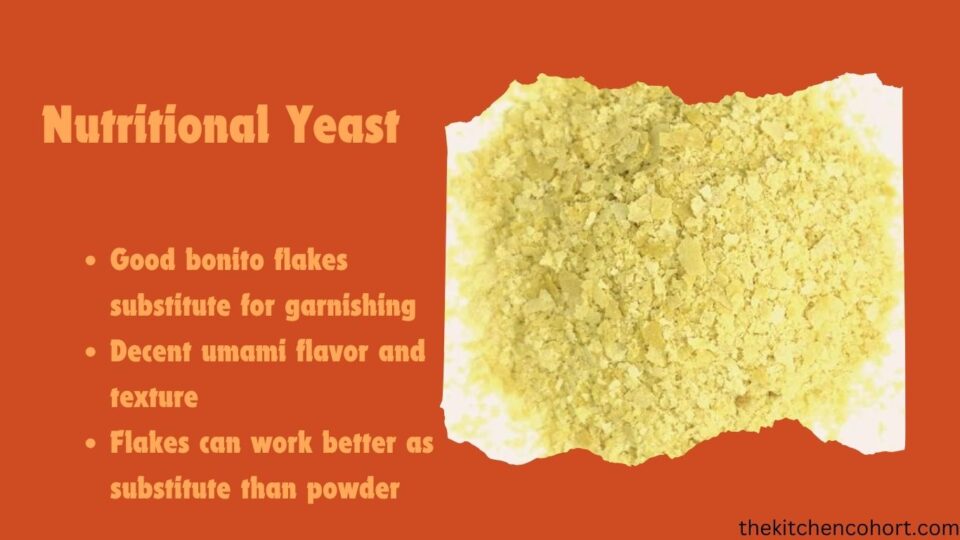
Nutritional yeast can be a decent substitute for bonito flakes, especially when used as a garnish. If you use flaked nutritional yeast, the texture can be very similar to bonito flakes. Plus, the nutritional yeast has a good touch of umami flavoring, so it can pull off being used as an alternative.
Adjust the amount of nutritional yeast to the recipe to better match your taste preferences.
8. Nori With Dulse Flakes
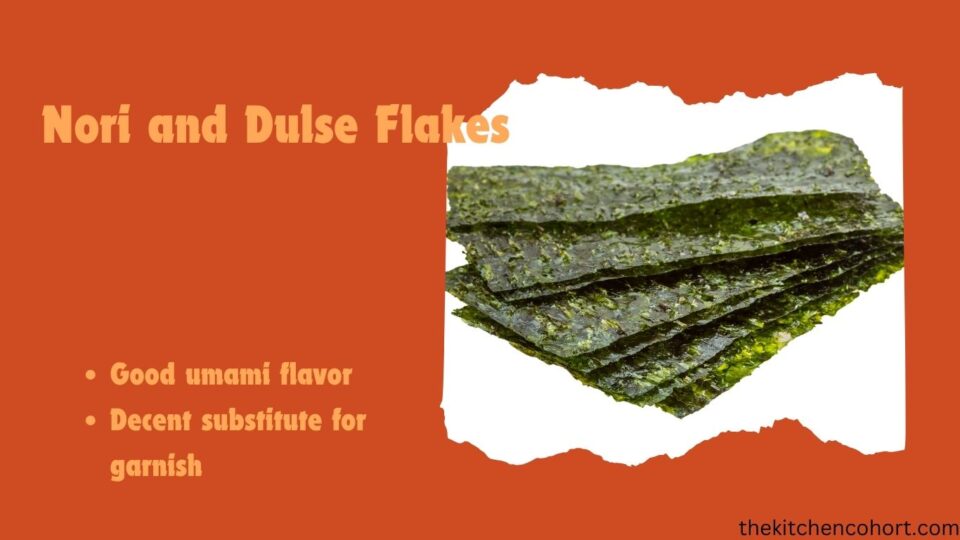
Dulse flakes can have a similar umami touch as Bonito flakes, though they lack the more complex and smoky flavors. Yet, if you find yourself in need of a quick substitute for bonito flakes, dulse flakes can work, though it’s not an ideal substitution.
One problem some people have with using dulse flakes is that they can get too chewy and can have a difficult texture when used as a garnish. One way around this problem is roasting the dulse flakes, which makes them crispy, rather than chewy.
Apart from dulse, you can also add some nori, which is roasted seaweed. This too adds to the overall flavor and texture of the recipe, allowing for a nice garnish.
9. Using Fish Shells

Using small fish shells for stock can work when preparing a dashi without bonito flakes. Shrimp or shellfish stock is a great way to get the right base for dashi.
Shrimp shells are a great choice for this, though they can be difficult to get hold of. You can also try scallop or oyster shells for this stock. Adding a small amount of chicken stock to this could work as well.
It might also be worthwhile to consider using dried prawns or prawn stock.
10. Bonus: Consider These Additives
As we know, there is no single, right alternative to bonito flakes. Several items find a place on our list, but there is more you can do to get the umami, smoky, and salty flavors of bonito flakes.
By themselves, these additives probably won’t work all that well as substitutes. However, you can combine them with other options to get the best results.
- Liquid Smoke: Due to their curing process, bonito flakes have a smoky flavor that’s missing in most substitutes. Adding a drop or two of liquid smoke should fix this issue.
- Adzuki Beans and Soybeans: Adzuki beans and soybeans have been used in dashi and other foods for a long time, often in place of ingredients like bonito flakes. Generally, these were used by Buddhist monks who wanted vegetarian food. It’s still possible to enhance the flavor of the food by using these beans. Remember to soak the beans before using them, preferably overnight, but at least an hour.
- Chicken Stock: In case the dashi you made without bonito flakes appears to be missing some flavor, consider adding a bit of chicken stock to get a rich flavor.
- Disodium Inosinate: Commercially, disodium inosinate is sold as a flavor enhancer, much like MSG (monosodium glutamate). It brings a wonderful umami flavor and can be the heart of a recipe. Katsuobushi is rich in disodium inosinate. So, this flavor enhancer is a natural addition for several recipes where you want deeper flavors, especially where you’re substituting for bonito flakes.
This compound can be extracted from plant or animal sources. So, if you have vegan or vegetarian diet preferences, it’s best to check the label before you buy.
Making The Right Choice For Your Bonito Flakes Substitute
As we go through the process of finding the best bonito flakes substitute, it’s best to keep your specific preferences and recipe in mind. Some of these substitutes will work for dashi, while others will work for a garnish or a filling. So, rather than taking a one-size-fits-all approach, these suggestions are intended to be something to suit your recipe.
Also, the substitutes include some vegan and vegetarian options you can consider, making things easier for different diet plans or preferences.
That said, nothing can substitute for your creativity and skill in the kitchen. So, let your creativity fly and make the best of the recipe and available ingredients.

